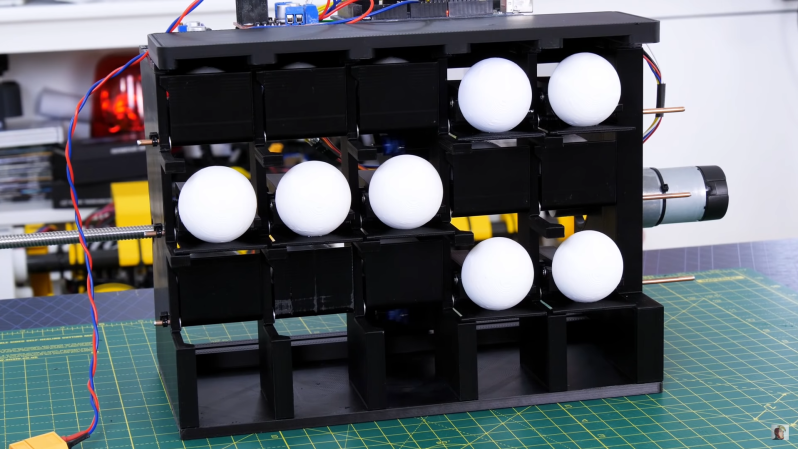Flip dots displays are timeless classics, but driving the large ones can quickly turn into a major challenge. The electromagnets require a lot of current to operate, and the driver circuits can get quite expensive. [James Bruton] wanted to build his own, but followed a bit of a different route, building a mechanically multiplexed flip dot (ball?) display.
Each of the dots on [James]’ 5×3 proof of concept is a bistable mechanical mechanism that can either show or hide a ping pong ball sized half sphere. Instead of using electromagnets, the dots are flipped by a row of micro servos mounted on a moving carriage behind the display. The mechanism is derived from one of [James]’ previous projects, a mechanical multiplexer. Each dot mechanism has a hook at the back of the mechanism for a servo to push or pull to flip the dot. A major disadvantage of this design is the fact that the servo horn must match the state of the dot before moving through the hook, otherwise it can crash and break something, which also reduces the speed at which the carriage can move.
This build was just to get a feel for the concept, and [James] already has several ideas for changes and improvements. The hook design can certainly change, and a belt drive would really speed things up. We think this mechanical display is a very interesting design challenge, and we are interested to hear how our readers would tackle it? Let us know in the comments below.
Recently we covered a 3D printed flip dot display for the first time. It’s still small and [Larry Builds] is working out the kinks, but we would love to see it eventually match the mesmerising effect of Breakfast’s large installations.















Cool! In 1983 they made a color version https://www.youtube.com/watch?v=J-gCBh6rk3M&t=11s
Now that’s something I’d like to see someone make a diy version of that’ll hang on a wall!
That video is easily the coolest thing I’m going to see today.
+1
Just the sheer amount of work digitalising the image. Just wow!
Wow. That video is a real life version of waiting for a .gif to load with a slow internet connection.
Aren’t servos overkill for flipping dots? Commercial displays use a bistable motor made of a permanent magnet between the poles of a C shaped electromagnet. Way cheaper.
I think he is aware of that. His aim was to build a mechanical flip dot display which doesn’t need controlling of a hundred rows and columns. He says so in the video, too. Just watch his other videos, he’s a mechanical guy!
I’ve been playing around with a similar flip-dot concept as well, although I must admit that your clever and apt Mechanically Multiplexed Flip-Dots is such an awesome description. Here is how I switched a push-pull actuating mechanism to a push-push that can be accomplished with a simple solenoid or similar linear actuator: https://hackaday.io/project/180131-exploring-flip-dots/log/193659-flipping-mark-2.
Is there such a thing like addressable LED’s (WS2812B RGB) where instead of an LED, it’s a small digital output that could trigger a mini solenoid? That way, all of them would be daisy chained and addressable … switched just like a WS2812
or a mini solenoid with the circuitry built-in (like the serial in and out as a WS2821)
EDIT:
I guess my real question should be: Has anyone ever seen a schematic for a WS2812B addressable LED? I wonder if it could be utilized for other things?
You are describing a shift register – or the be more precise: A push-pull capable shift register / output driver.